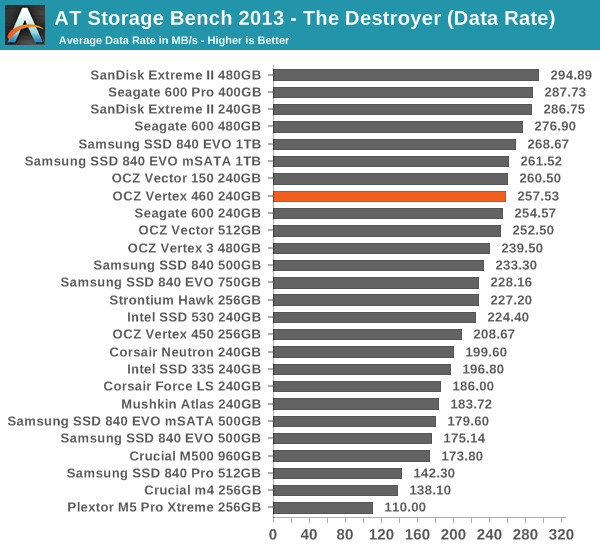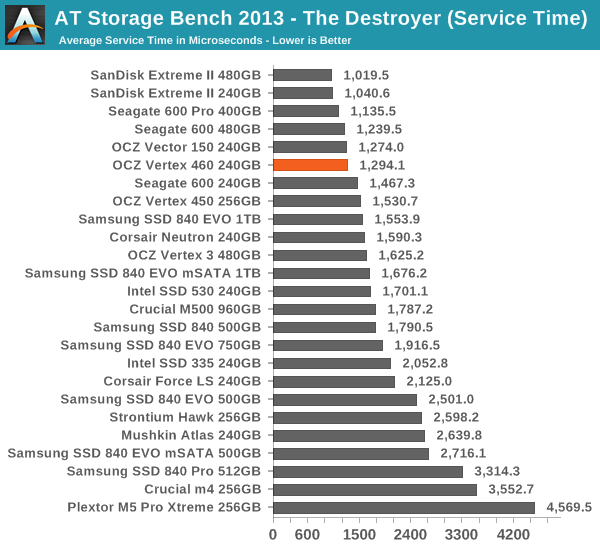OCZ Vertex 460 (240GB) Review
by Kristian Vättö on January 22, 2014 9:00 AM EST- Posted in
- Storage
- SSDs
- OCZ
- Indilinx
- Vertex 460
AnandTech Storage Bench 2013
When Anand built the AnandTech Heavy and Light Storage Bench suites in 2011 he did so because we did not have any good tools at the time that would begin to stress a drive's garbage collection routines. Once all blocks have a sufficient number of used pages, all further writes will inevitably trigger some sort of garbage collection/block recycling algorithm. Our Heavy 2011 test in particular was designed to do just this. By hitting the test SSD with a large enough and write intensive enough workload, we could ensure that some amount of GC would happen.
There were a couple of issues with our 2011 tests that we've been wanting to rectify however. First off, all of our 2011 tests were built using Windows 7 x64 pre-SP1, which meant there were potentially some 4K alignment issues that wouldn't exist had we built the trace on a system with SP1. This didn't really impact most SSDs but it proved to be a problem with some hard drives. Secondly, and more recently, we've shifted focus from simply triggering GC routines to really looking at worst-case scenario performance after prolonged random IO.
For years we'd felt the negative impacts of inconsistent IO performance with all SSDs, but until the S3700 showed up we didn't think to actually measure and visualize IO consistency. The problem with our IO consistency tests is that they are very focused on 4KB random writes at high queue depths and full LBA spans–not exactly a real world client usage model. The aspects of SSD architecture that those tests stress however are very important, and none of our existing tests were doing a good job of quantifying that.
We needed an updated heavy test, one that dealt with an even larger set of data and one that somehow incorporated IO consistency into its metrics. We think we have that test. The new benchmark doesn't even have a name, we've just been calling it The Destroyer (although AnandTech Storage Bench 2013 is likely a better fit for PR reasons).
Everything about this new test is bigger and better. The test platform moves to Windows 8 Pro x64. The workload is far more realistic. Just as before, this is an application trace based test–we record all IO requests made to a test system, then play them back on the drive we're measuring and run statistical analysis on the drive's responses.
Imitating most modern benchmarks Anand crafted the Destroyer out of a series of scenarios. For this benchmark we focused heavily on Photo editing, Gaming, Virtualization, General Productivity, Video Playback and Application Development. Rough descriptions of the various scenarios are in the table below:
| AnandTech Storage Bench 2013 Preview - The Destroyer | ||||||||||||
| Workload | Description | Applications Used | ||||||||||
| Photo Sync/Editing | Import images, edit, export | Adobe Photoshop CS6, Adobe Lightroom 4, Dropbox | ||||||||||
| Gaming | Download/install games, play games | Steam, Deus Ex, Skyrim, Starcraft 2, BioShock Infinite | ||||||||||
| Virtualization | Run/manage VM, use general apps inside VM | VirtualBox | ||||||||||
| General Productivity | Browse the web, manage local email, copy files, encrypt/decrypt files, backup system, download content, virus/malware scan | Chrome, IE10, Outlook, Windows 8, AxCrypt, uTorrent, AdAware | ||||||||||
| Video Playback | Copy and watch movies | Windows 8 | ||||||||||
| Application Development | Compile projects, check out code, download code samples | Visual Studio 2012 | ||||||||||
While some tasks remained independent, many were stitched together (e.g. system backups would take place while other scenarios were taking place). The overall stats give some justification to what we've been calling this test internally:
| AnandTech Storage Bench 2013 Preview - The Destroyer, Specs | |||||||||||||
| The Destroyer (2013) | Heavy 2011 | ||||||||||||
| Reads | 38.83 million | 2.17 million | |||||||||||
| Writes | 10.98 million | 1.78 million | |||||||||||
| Total IO Operations | 49.8 million | 3.99 million | |||||||||||
| Total GB Read | 1583.02 GB | 48.63 GB | |||||||||||
| Total GB Written | 875.62 GB | 106.32 GB | |||||||||||
| Average Queue Depth | ~5.5 | ~4.6 | |||||||||||
| Focus | Worst-case multitasking, IO consistency | Peak IO, basic GC routines | |||||||||||
SSDs have grown in their performance abilities over the years, so we wanted a new test that could really push high queue depths at times. The average queue depth is still realistic for a client workload, but the Destroyer has some very demanding peaks. When we first introduced the Heavy 2011 test, some drives would take multiple hours to complete it; today most high performance SSDs can finish the test in under 90 minutes. The Destroyer? So far the fastest we've seen it go is 10 hours. Most high performance SSDs we've tested seem to need around 12–13 hours per run, with mainstream drives taking closer to 24 hours. The read/write balance is also a lot more realistic than in the Heavy 2011 test. Back in 2011 we just needed something that had a ton of writes so we could start separating the good from the bad. Now that the drives have matured, we felt a test that was a bit more balanced would be a better idea.
Despite the balance recalibration, there is just a ton of data moving around in this test. Ultimately the sheer volume of data here and the fact that there's a good amount of random IO courtesy of all of the multitasking (e.g. background VM work, background photo exports/syncs, etc...) makes the Destroyer do a far better job of giving credit for performance consistency than the old Heavy 2011 test. Both tests are valid; they just stress/showcase different things. As the days of begging for better random IO performance and basic GC intelligence are over, we wanted a test that would give us a bit more of what we're interested in these days. As Anand mentioned in the S3700 review, having good worst-case IO performance and consistency matters just as much to client users as it does to enterprise users.
We are reporting two primary metrics with the Destroyer: average data rate in MB/s and average service time in microseconds. The former gives you an idea of the throughput of the drive during the time that it was running the Destroyer workload. This can be a very good indication of overall performance. What average data rate doesn't do a good job of is taking into account response time of very bursty (read: high queue depth) IO. By reporting average service time we heavily weigh latency for queued IOs. You'll note that this is a metric we've been reporting in our enterprise benchmarks for a while now. With the client tests maturing, the time was right for a little convergence.

The Vertex 460 is only a hair slower than the Vector 150 in our Storage Bench 2013. The difference actually falls into the margin of error, so it seems that in spite of the lower clock speed, the performance is essentially the same.











69 Comments
View All Comments
jragonsoul - Wednesday, January 22, 2014 - link
But they really aren't, OCZ is still OCZ and they are still making their own drives. I see that as a smart move by them because if Toshiba would have swallowed the company and they made some SSD's I know at least me and my tech friends would have stayed well and far away until EXTENSIVE reviews appeared.AssBall - Wednesday, January 22, 2014 - link
OCZ had a bad run of drives and couldn't get it fixed. Years before that, they made excellent memory, and good PSU's. Their early SSD's were pretty good too. Being hung up on their screw up sounds like you can't get over personal issues. They will come back and be profitable again. Toshiba will help right the ship.Samus - Wednesday, January 22, 2014 - link
Yep. Let's not forget those poor early adopters of MacBook Air's that were unlucky enough to end up with a Toshiba drive instead of a Samsung (Apple was using both vendors through production, so it was luck of the draw)Needless to say Apple doesn't use Toshiba SSD's much anymore, even with their bitterness with Samsung.
lmcd - Thursday, January 23, 2014 - link
"Much."So?
DarkStryke - Wednesday, January 22, 2014 - link
You have some pretty nice revisionist history there. Take your own advice and learn about the history of OCZ, especially before the company incorporated under that title.I hear the overclockerz store had great customer service too!
Once a fool..
GTVic - Thursday, January 23, 2014 - link
My OCZ power supply died precisely after the warranty expired.random2 - Sunday, February 2, 2014 - link
You cannot blame a person for feeling that the OCZ name is a deterrent. Doesn't even have to be personal to want to see people avoid product that has not been good for years, hasn't been good through numerous models of drives, and has casued a great many people a lot of heart ache and frustration. All becasue OCZ couldn't bring themselves to make sure their product was viable and market ready BEFORE it went out their door.http://www.behardware.com/articles/881-7/component...
Go ahead....buy an OCZ drive.
AMRAAM_Missiles - Thursday, March 20, 2014 - link
Eventhough you make sense, that the company has a dark area which it lost the trust from a lot of people, it doesn't mean that it won't get better.My first ever SSD was the Vertex 4 from OCZ, and guess what, it is still regarded as one of the best Performance SSD that money could buy today. 3 solid years of grinding the OS with constants write and read, it shows no drop in performance. I am not saying that failures are not real, but it doesn't go the extend that people make it out to be.
Now, i have just bought another Vector and Vector 150 for my rig, and i couldn't be more happier with a role of a normal consumer and an enthusiast of PC in general. Sometime, people just have to hate for the sake of hating without even trying to open their eyes to verify the current situation a little bit.
JDG1980 - Wednesday, January 22, 2014 - link
That was my thought, as well. The purchase of OCZ made sense, because they have some decent controller IP and Toshiba wasn't too strong in that area, but the OCZ name is dirt because of their horrendous record of reliability, so I have no idea why they wanted to keep that.Samus - Wednesday, January 22, 2014 - link
I remember an interview Anand posted years ago with the CEO of OCZ, and Anand was pretty adamant about them ditching their name (for obvious reasons) and the CEO said they were going to keep it. That didn't work out so great for them. I don't see it working for Toshiba, either. They need to ditch the name and come up with another one, or just call it Toshiba.